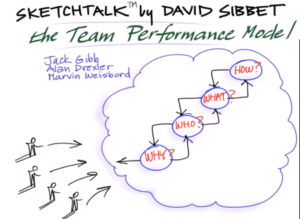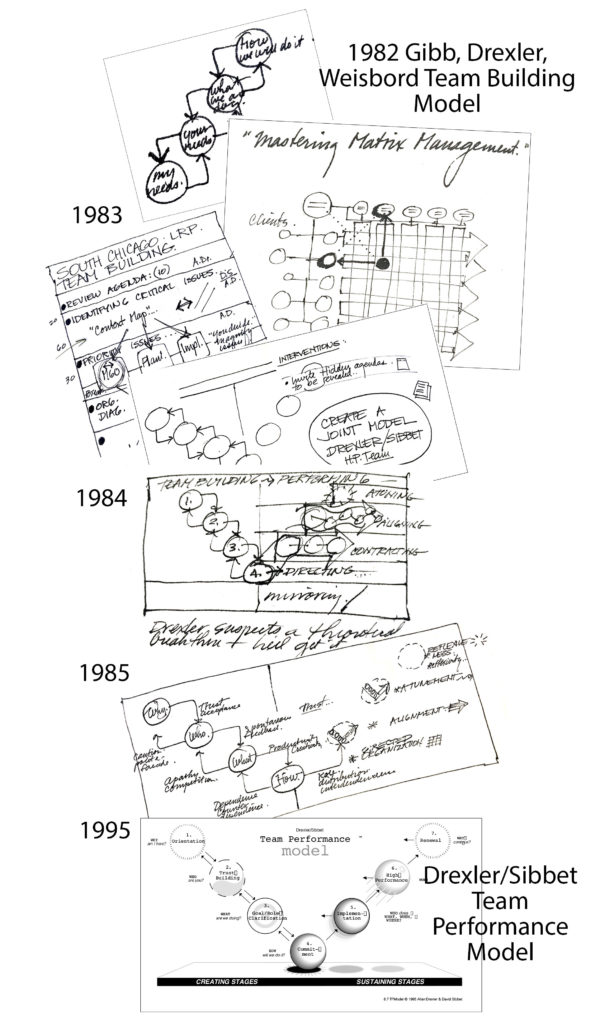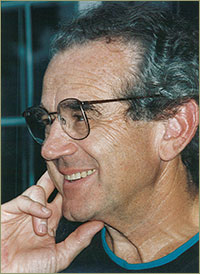Allan Drexler: In Appreciation
I was saddened to hear that my friend and colleague Allan Drexler passed away recently. He was 88. In the 1980s, he and I co-developed the Drexler/Sibbet Team Performance Model® (Model) and the facilitative methods and tools connected with it. Without Allan we would not have this model. The depth of his field experience with teams, coupled with his deep understanding of group dynamics developed in sensitivity training work at National Training Labs, kept the work grounded in the real world of working teams.
How the Work Began
I first met Allan in 1982, when I gave a workshop about facilitation that included Arthur M. Young’s Theory of Process. Allan shared a team-building model he had developed with Jack Gibb, an influential social science researcher, and Marv Weisbord, a thought leader in organizational development. It laid out predictable questions people ask when joining a group: Why are we here? Who are you? What are we doing? How will we work together? (The model is illustrated here in a Sketchtalk I did on the subject).
At that time Allan was working extensively with matrix-type organizations. He invited me to explore writing a book on the subject as well as collaborating with him in his General Mills client work. A year of productive work together led to our offering a Creating and Leading High Performing Teams workshop through National Training Labs. Ultimately we led five of these workshops. We also involved Russ Forrester, who co-led the program with Allan well into the 2000s.

This graphic is a composite of journal drawings over the years I worked with Allan on developing the Team Performance Model
The idea of integrating Allan’s model with Process Theory emerged in the process of designing that program for teams. I realized that the Gibb, Drexler, Weisbord Team Building Model mapped perfectly onto the first stages of Process Theory, in which I was immersed. I had a hunch that the Theory of Process would also describe what happens after a team forms. Allan had been using another model for contracting to describe this part of the process.
Aligning on Nomenclature
Allan loved dialogue, to which he brought a keen wit and the tenacity of a true New Yorker. We had ongoing and robust debate over every element of the emerging Team Performance Model, especially around nomenclature. For example, the word “commitment” is frequently used to represent a willingness to enter emotionally into a process or relationship. It also applies to the very bottom line kinds of commitments involved in contracts and joint ventures. We came to agree that we wanted the word “commitment” to reflect the more concrete aspects of financial, calendar and staff commitments—the essentials in getting real results. Likewise we chose the word “trust” to define the second stage when people are assessing “who” they are working with. A popular Tuchman model of teaming calls this stage “storming,” but we felt that pointing to trust was more universally useful.
Supporting Meaningful Conversations
The Model was developed hand in hand with an assessment tool we called the Team Performance Inventory, co-created with Russ Forrester, who had been trained in assessment work. Allan’s insight was that the real value of these tools was to initiate the right conversations on the team. He believed that that real teamwork developed through engagement and mutual understanding .He also knew from his long experience that people trust data and consider it “valid” if it comes from them, rather than from an outside observer. Because people’s answers to written questions are deeply embedded in their widely varying assumptions and interpretations, dialogue about what the assessment answers actually mean is the active catalyst for involvement.
As we developed the Inventory, we agreed that people would need indicators of the behaviors and characteristics for each of the seven stages—both for issues that have been successfully “resolved” and issues that remain “unresolved.” These indicators became the basis of the team assessments that were developed later.
The Team Leader Guide
In addition to the Model and the Inventory, we created a Team Leader Guide featuring a compilation of the best practices that The Grove and Allan had developed over the years. After gaining clarity about what was working and not working in their team, people were invited to try some new practices that addressed how they mutually agreed they would like to improve their team’s performance.
Grounded in Clear Agreements
 As I reflect back on all I learned from Allan, I keep thinking about the care with which he would introduce these tools to clients. He believed strongly that creating a “social contract” with leaders and teams about what they hoped to accomplish was key to creating an environment for having truly deep discussions that could change behavior and performance. He would insist that team leaders be fully enrolled in the aim of creating a rich dialogue, while avoiding any kind of performance management in which people would be evaluated or disciplined as a result of taking the Inventory. Allan felt it was equally important to “contract” with the team itself about how they would approach taking the assessment and participating in a team improvement meeting. To this day the importance of these social contracts remains a feature in my own consulting, thanks to his coaching.
As I reflect back on all I learned from Allan, I keep thinking about the care with which he would introduce these tools to clients. He believed strongly that creating a “social contract” with leaders and teams about what they hoped to accomplish was key to creating an environment for having truly deep discussions that could change behavior and performance. He would insist that team leaders be fully enrolled in the aim of creating a rich dialogue, while avoiding any kind of performance management in which people would be evaluated or disciplined as a result of taking the Inventory. Allan felt it was equally important to “contract” with the team itself about how they would approach taking the assessment and participating in a team improvement meeting. To this day the importance of these social contracts remains a feature in my own consulting, thanks to his coaching.
Because Allan lived on the East Coast and travel was always a feature of our collaboration, we eventually developed separate practices with these tools. He and his colleague Russ Forester went on to develop several additional tools, as did The Grove. We agreed to sustain the Model by consensus and not make changes to it without dialogue. Our achievement in that area is part of why the tools have become so widely used.


ful crimetis
July 13, 2021drexler was a piece of dung. this author can sadly remember him any way he wants but that doesn’t change the facts.
Russell Bong
January 17, 2020I too just learned of Allan’s passing. I was introduced to Allan early on in my career while I was the Marketing Director at NTL Institute (National Training Labs). As a marketer, I enrolled in many of NTL’s courses to learn first-hand the experience that our customers were having. There were two courses where Allan was my trainer: the Human Interaction Laboratory and Creating and Sustaining High Performing Teams. These two courses, as well as others I took, have had a profound impact on the future direction of my career.
Allan was an avid tennis player. The visual depiction of the seven stages of the Team Performance Model is based on a tennis ball bouncing at the “Decision Making” phase of performance. At one of the training programs held at Safety Harbor, FL, Allan asked me if I wanted to play a game of tennis with him. I was not an avid tennis player but I took him up on his invitation. Because of my lack of tennis skill, Allan gave me pointers and suggested we work on volleying the ball over the net. What I realized as we played tennis was that he was very kind, understanding and empathetic while also being very much a coach-in this case, a tennis coach.
I ran into him having dinner with his Father who resided in an assisted living facility near the Safety Harbor resort. Allan invited me to join him and his father. As David stated above, it was all about the dialogue with Allan!
Of all of the trainers I had at NTL, Allan stands out as the one from whom I learned the most.
What I learned from Allan directly or experientially has always remained with me. He didn’t know it but he was a mentor who had a profound impact on my abilities and thus my profession.
I have used his techniques and methodologies ever since our first training session. These techniques are foundational to my present-day work in the high-tech space. The Team Performance Model is and always has been my go to model for team building and performance enhancement. To spark insight, I often find myself going back to the now yellowing pages of my NTL Institute Creating and Sustaining High Performing Teams training manual that I received from Allan years ago. At present, I am designing an instrument to assess how two companies can better work together as one company (a classic acquisition scenario). Where do I start? I turn to that incredible manual to stimulate ideas. That’s why I was curious to Google Allan to see what he has been up to only to learn of his passing.
I appreciate the work that you (David), Russ and Allan did. The value of the Team Performance Model remains undiminished. Thank you for persevering together as a team to create such a wonderful masterpiece that will be used for years to come.
Kathleen Spitz
March 15, 2018I am just now learning of Allan’s passing. I was introduced to Allan and his work (with you and Russ ) over 25 years ago . I had the pleasure of working with Allan at Eastman Kodak and GlaxoSmithKline. The Team Performane Model is, still, to this day, my “go to Model” for all the Team Development work that I do. It has never , ever failed me.
I hold Allan in my heart as a mentor , even if he didn’t know it! Watching him in action and learning from him impacted the way I do my work with teams in significant and profound ways .
I appreciate his work , your work and Russ’s work more than words can describe.
I believe that if every Team had the benefit of using the Team Performance Model, Well—-we could change the world! That’s how much I believe in it. It works!!